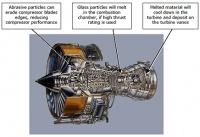Britain’s Air Traffic Control Service (Nats) said that flights would be grounded from midday and it is unclear when the planes will be safe enough to fly again.
The measures have been taken based on guidelines that advise pilots not to fly through an ash cloud because of the serious problems it can cause to the plane’s engines.
Sheffield University’s Prof Haydn Thompson explained: ‘Volcanic ash is very abrasive, which can damage the front-facing parts of the aircraft and that includes the front compressor or fan of the gas turbine engine.
‘But the other problem with ash is that it melts and if you get high temperatures in the combustion sections of the engine it can actually melt and stick to the combustion sections and clog things up.’
Dr Tim Fox, head of Energy and Environment at the Institution of Mechanical Engineers, added: ‘Modern jet engines are highly technological machines that work by sucking air in through a large fan and using it in a combustion process to generate thrust.
‘If, for example, foreign objects such as the introduction of large amounts of grit or volcanic ash were to be sucked into the air, this would result in serious damage to the fan blades and internal surfaces of the engine. In turn, this would interfere with combustion, ultimately resulting in engine failure.’
In June 1982, a British Airways 747 flight from London to Auckland faced a cloud of ash from Mount Galunggung in Java, Indonesia. The plane’s four engines failed, however, three reignited and the plane was able to make an emergency landing.

More than 80 aircraft are reported to have flown into volcanic ash cloud between 1980 and 2000, with consequences ranging from increased wear of engines to simultaneous power loss in all engines.
Volcanic ash is made up of highly abrasive particles that may damage aircraft components, particularly forward-facing surfaces of external parts and engine components. They are made of sharp rock fragments that will easily erode plastic, metal and even glass pieces.
In-service events show that aircraft may suffer from extensive damage after volcanic ash encounter. In some cases, all the following parts were removed and replaced, after they were sand blasted:
• Windshields
• Forward cabin windows
• Navigation and landing lights cover
• Wing, stabiliser and fin leading edges
• Engine nose cowls and thrust reversers
• All pitot and static probes
Ingestion of volcanic ash by engines may cause serious deterioration of engine performance due to erosion of moving parts and/or partial or complete blocking of fuel nozzles.
Volcanic ash contains particles, whose melting point is below engine internal temperature. In flight, these particles will immediately melt if they go through an engine. Going through the turbine, the melted materials are rapidly cooled down, stick on the turbine vanes, and disturb the flow of high-pressure combustion gases.
This disorder of the flow may stall the engine, in worst cases.
Volcanic ash may carry high static charge that makes it difficult to remove from electronic components.
Ash deposit easily absorbs water and can cause arcing, short circuits and intermittent failures of electronic components.
Dense ash deposit can clog bleed system filters and may lead to total bleed loss, with associated loss of cabin pressurisation.
Source: Airbus





Swiss geoengineering start-up targets methane removal
No mention whatsoever about the effect of increased methane levels/iron chloride in the ocean on the pH and chemical properties of the ocean - are we...